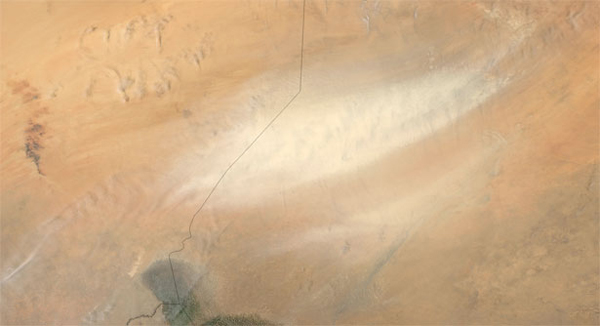Amazon Rainforest Gets Half Its Nutrients From Tiny Spot in Sahara | Saúde da floresta amazônica
Today in astonishment: The Amazon rainforest gets half its nutrients from a single, tiny spot in the Sahara
By Alexis Madrigal
The Atlantic
The Amazon basin is one of the world’s wondrous ecosystems, supporting massive amounts of life, both in kind and quantity. You might have thought about poison frogs or monkeys, but you’ve probably never stopped to wonder,
“Where are all the nutrients that power this biotic explosion coming from?”
The answer is actually astonishing and delightful in that one-planet-one-love kind of way. As laid out in a 2006 paper that science writer Colin Schultz dug up, nearly half of the nutrients that power the Amazon come from a valley in the Sahara called the Bodélé depression. At 17,100 square miles, the area is about a third of the size of Florida or 0.5 percent the size of the Amazon basin it supplies.
“This depression is a unique dust source due to its location at a bottle neck of two large magmatic formations that serves as a `wind lens’, guiding and focusing the surface winds to the Bodélé,”
the authors, an international team of geologists, wrote.
This is what that looks like.

The study shows that the dust emitted from the Bodélé amounted to more than 60 Tg (60 million metric tons) in the year spanning Oct 2003 to Oct 2004.
The dust storms that come swirling out of the Sahara can cover an area larger than the United States. That’s the only scale that could deliver 40 million tons of dust from Africa to the Amazonian basin each year.
ABSTRACT FROM ORIGINAL PAPER
The Bodélé depression: a single spot in the Sahara that provides most of the mineral dust to the Amazon forest. By Ilan Koren, Yoram J Kaufman, Richard Washington, Martin C Todd, Yinon Rudich, J Vanderlei Martins and Daniel Rosenfeld. Environ. Res. Lett. 1 (Oct –Dec 2006), doi:10.1088/1748-9326/1/1/014005
About 40 million tons of dust are transported annually from the Sahara to the Amazon basin. Saharan dust has been proposed to be the main mineral source that fertilizes the Amazon basin, generating a dependence of the health and productivity of the rainforest on dust supply from the Sahara. Here we show that about half of the annual dust supply to the Amazon basin is emitted from a single source: the Bodélé depression located northeast of Lake Chad, approximately 0.5% of the size of the Amazon or 0.2% of the Sahara. Placed in a narrow path between two mountain chains that direct and accelerate the surface winds over the depression, the Bodélé emits dust on 40% of the winter days, averaging more than 0.7 million tons of dust per day.
Source: The Atlantic | Featured image: Chad Desert
Saúde da floresta amazônica
Amazonia News
Mais da metade do pó necessário para fertilizar a floresta tropical brasileira é fornecida por um vale no norte do Chade, de acordo com uma equipe internacional de pesquisadores liderada pelo Dr. Ilan Koren do Meio Ambiente do Instituto Ciências e Pesquisa do Departamento de Energia. Em um estudo publicado recentemente na Environmental Research Letters, os cientistas explicaram como as características únicas do vale do Bodele pode ser responsável por torná-lo como um prestador de poeira maiores.
Ficou conhecido por mais de uma década que a existência da floresta amazônica depende de um fornecimento de minerais lavado pela chuva do solo no deserto do Saara e soprado através do Atlântico pela poeira. Ao combinar vários tipos de dados de satélites, o Dr. Koren e colegas de Israel, o Reino Unido, Estados Unidos e Brasil têm agora pela primeira vez, conseguiu obter informações quantitativas sobre o peso do pó. A análise das quantidades de pó foram realizadas perto do vale Bodele si, na costa do Atlântico e em um ponto mais acima do oceano.
Os dados revelaram que cerca de 56 por cento do pó atingir a floresta amazônica tem origem no vale Bodele. Eles também mostraram que um total de cerca de 50 milhões de toneladas de poeira fazem o seu caminho de África para a Amazônia a cada ano, um valor muito superior à estimativa anterior de 13 milhões de toneladas. A nova estimativa corresponde aos cálculos sobre a quantidade de pó necessária para fornecer os minerais vitais para a manutenção da floresta amazônica.
Os pesquisadores sugerem que o vale Bodele é uma fonte tão importante de pó, devido à sua forma e características geográficas: é flanqueado de ambos os lados de basalto cumes enormes da montanha, que cria uma cratera forma de cone com uma abertura estreita no nordeste. Ventos que drenam “em foco vale neste funil, como a abertura de forma semelhante ao modo como a luz é focalizada por uma lente óptica, a criação de um túnel de vento grande quantidade de tipos. Como resultado, rajadas de vento de superfície que são acelerados e focados no túnel de levantar a poeira do chão e fundi-lo em direção ao oceano, permitindo que o vale Bodele a exportação da grande quantidade de poeira que faz uma contribuição de vida sustentável para a Amazônia floresta.
Source: Amazonia News










Comments
Amazon Rainforest Gets Half Its Nutrients From Tiny Spot in Sahara | Saúde da floresta amazônica — No Comments